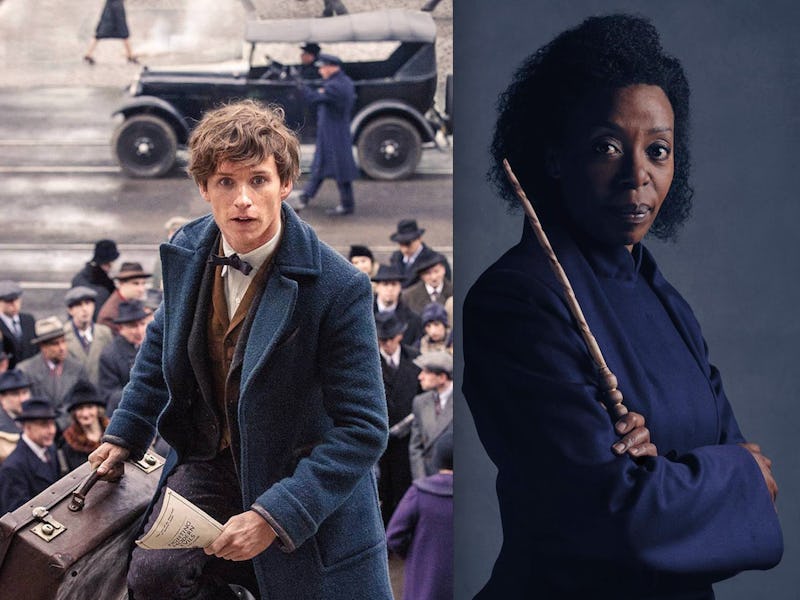Here's Everything Harry Potter Did in 2016
From 'Cursed Child' to 'Fantastic Beasts' to controversies, the Wizarding world has had a busy year.

Between a startling amount of celebrity deaths (Bowie; Prince; Gene Wilder), and the death of reason and human decency (Brexit; Donald Trump), there is a general consensus that 2016 has been an exceptionally shitty year. At least, in the Muggle and No-Maj World.
For the Wizarding world, it’s been a whirlwind. Between Harry Potter and the Cursed Child and Fantastic Beasts and Where to Find Them, the Harry Potter franchise saw more action in 2016 than it has in five years. The world has never needed Potter more, and it’s risen to the occasion. From the good parts to the bad parts, to the parts that made us feel like we’ve been hit with a Confundus Charm, here’s everything Harry Potter did in 2016.
The Bad: A cultural appropriation controversy.
In a Pottermore series called “History of Magic in North America,” J.K. Rowling used lore from various Native traditions like the Navajo Skinwalkers to explain the evolution of magic in North America. Rowling immediately came under fire for appropriating from Native American culture. Particularly because the Potter books emphasize understanding the “other,” rewriting Native American myths —whether or not it was intentional — clashed with Rowling’s own ideals. It was a not-great lead into Fantastic Beasts and Where to Find Them.
The Good: Casting a Black Hermione.
When the play Harry Potter and the Cursed Child cast actress Noma Dumezweni as its Hermione, it validated millions of Black and mixed race Potter fans who had grown up searching for themselves in its pages. Obviously one does not need to share exterior qualities with a character in order to emphasize with them, but it sure does makes it more meaningful — especially when non-white representation is all too rare for major franchises. Since the “Mudblood” slur is a thinly veiled commentary on racism, this development perfectly fit the Potter world. It helped that Hermione then ended up being a kickass Minister for Magic to boot.
The Bad: Traveled back in time — in a questionable way.
Harry Potter and the Cursed Child might have gotten favorable reviews onstage, but for the millions of fans who only had access to the script, this particular addition to the Potter story was not a success. Between Voldemort having a secret child, Ron forgetting his characterization, and time travel mishaps involving Cedric Diggory, its overall plot felt like bad fanfiction. In fact, since Potter fanfiction is its own expansive world, there’s lots of better fanfiction out there. As for the scene with the Trolley witch, revealed as a secret monster creature with spike hands and grenade treats, that’s best left unmentioned.
The Good: Traveled back in time — in a cool way.
Although Fantastic Beasts and Where to Find Them doesn’t use any actual Time-Turners the way Cursed Child does, its setting of Prohibition-era New York offered a different portrait of the Wizarding world than what we’re used to. Give or take a questionable justice system, the trip to the Wizarding world past was a glorious dapper-vested, speakeasy-filled treat.
The Bad: A controversial Patronus quiz.
In addition to its questionable take on Magic in North America, Pottermore unveiled a new Patronus quiz that did not land well among many fans. Face it, everyone wants a Patronus as cool as Harry’s stag. Although the new quiz offered a few along those lines — cats; dolphins — it seemed to offer far more lame ones, like turkey vultures or weasels.
## The Good: Expanded the Black family tree.
Fantastic Beasts and Where to Find Them revealed that Newt Scamander’s long lost love is a woman named Leta Lestrange. Although she did not appear onscreen in the first Fantastic Beasts movie, the name “Lestrange” connects her to Bellatrix, and her cousin Sirius Black. As the Blacks have always been the most fascinating Wizarding family, the more we know about them, the better.
The Bad: Include Johnny Depp.
Johnny Depp is playing Gellert Grindelwald. While this might have been welcome news ten years ago — when he was most known for Edward Scissorhands and Captain Jack Sparrow — in light of the abuse allegations in his personal life, this landed like a lead zeppelin among fans. Particularly because the Potter stories revolve around fighting authoritarianism and abuse, this was a tone-deaf move for the franchise.
The Good: Explained Dumbledore’s sister’s death.
The tragic death of Ariana Dumbledore has long been one of the most intriguing subplots in Harry Potter and the Deathly Hallows. Along with Harry, fans learned that Dumbledore’s sister suffered a traumatic attack in her youth and subsequently repressed her magic. As Aberforth Dumbledore explained, this caused her to suffer from episodes where her magic burst forth in ways that harmed others. In Deathly Hallows, Aberforth’s tale was sad and captivating, yet rather vague.
But thanks to Ezra Miller’s Credence Barebone in Fantastic Beasts, we are now able to put a name and face on Ariana’s condition. Like Credence, she was an Obscurus. It’s a messy and dark kind of magic — but it’s also rather magical that we’re able to look at old events with a new understanding.
2016 feels like Dementors have descended upon the world, but throughout it all, Harry Potter has remained our Patronus.